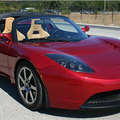Fifty years of spaceflight have taken people to the Moon and have sent unmanned vehicles zipping to the fringes of the solar system. What could the next 50 years bring?
Much more, or potentially not much more. Government-financed space travel could stall in the face of America’s growing aversion to risk and a kind of orbital ennui. NASA has, after all, already tried for more than a decade to develop follow-on vehicles to the flawed space shuttle and is in the process of trying again.
Private enterprise is stepping up, but the industry is still fragile.
Michael D. Griffin, the NASA administrator, said in an interview that he was confident of one thing for the foreseeable future: “We’re going to have a space program.”
Beyond that, all bets are off.
“The one thing of which we can be certain,” Mr. Griffin wrote in a recent essay on the Web site of the magazine Aviation Week and Space Technology, “is that in trying to envision the world of 2057, two generations in the future, we will be wrong.”
Experts in government, industry and science agree, however, that these three broad trends will shape the coming decades in space:
¶NASA has embarked on a program to return to the Moon by 2020, not just for what some critics call “flags and footprints,” but also for a lasting presence with scientific research and preparation for expeditions to asteroids and, eventually, Mars. The space shuttle program is being wound down by 2010 to create the next generation of vehicles.
¶Other nations, notably Russia and China, have ambitious plans and could spur a space race like the one that sent Americans to the Moon. “It took Sputnik for us to recognize what the Soviet Union was up to,” said Harrison H. Schmitt, who flew the last mission to the Moon, in 1972. “I don’t know what it will take this time.”
¶Private enterprise is moving ahead, beginning with space tourism and, later, transport services for NASA and other governments to outposts like the International Space Station. Beyond that, ventures could include mining on asteroids and manufacturing drugs in space.
John M. Logsdon, director of the space policy institute at George Washington University, says a big question has yet to be answered.
“At the level of government, I think we’re still struggling as to why we’re sending people to space,” Dr. Logsdon said. “It’s a decent question, and I think it’s an unanswered question.”
That leaves the manned space program at a precarious point, he said, adding: “If the current proposals to restart human exploration fail politically, indeed, the human space flight endeavor conducted under government auspices might well lose its momentum. I obviously hope that doesn’t happen. But it’s far from a slam dunk that we’re going back to the Moon and on to Mars.”
Entrepreneurs say they have the answer — money. Peter Diamandis, a founder of the Ansari X Prize, the $10 million competition to put a pilot in space without government financing, said that with all the energy and minerals to be found there “the first trillionaires are going to be made in space.”
In the next 50 years, Mr. Diamandis said, “economic engines,” not political ones, will push the space frontier.
Dr. Logsdon is skeptical. “There are a variety of alluring prospects that have been around almost since the start of the last 50 years that are still there as alluring prospects,” he said. “And we are not further along in knowing whether they can be turned into reality or not.” The continued reliance on chemical rockets, for example, limits the weight that can be taken into space.
Yet much has changed in the last 50 years that could lay the foundation for the next 50. A new generation of ultrawealthy entrepreneurs who grew up with a space fascination are pouring personal fortunes into making space businesses real.
Paul G. Allen, a founder of Microsoft, paid for SpaceShipOne, the tiny craft that won the X Prize in 2004. Elon Musk, a founder of PayPal, is developing rockets through his company, Space Exploration Technologies, and has NASA financing that could lead to his spacecraft’s carrying people and supplies to the International Space Station.
Jeffrey P. Bezos, founder of Amazon.com, is developing rockets at a site he owns in western Texas.
Robert Bigelow, who made his fortune in hotels, is developing a space transportation system and a space station that could be used as an orbiting hotel or a research base.
The official charged with regulating commercial spaceflight, Patricia Grace Smith of the Federal Aviation Administration, said in an interview, “When I look out 50 years from now, I fully expect that we will have actual, operational spaceports” that are commercially operated and owned.
At the dusty, sprawling Mojave Air and Space Port in California, dreamers and pragmatists join in planning the future.
Jeff Greason, the founder of Xcor Aerospace, one of several rocket companies there, said his industry was ready to talk big again after years of having to shake off the pixie dust of science fiction. “We had to stop focusing on the grand and glorious future,” he said, “because otherwise, people weren’t going to take us seriously as a business. We very consciously turned the vision thing off.”
“We’re making progress on real businesses that turn profits,” he added.
Other companies are already in the game. Mr. Greason’s neighbor, Scaled Composites, is working on a successor vehicle to its SpaceShipOne.
Richard Branson’s company, Virgin Galactic, which will buy the vehicles, has a long list of potential space tourists.
Esther Dyson, a longtime technology guru who is encouraging investment in space, said the development of rocket businesses paralleled the early days of personal computing and the Internet. Early government financing created technologies whose use was largely limited to government and academia.
“So eventually these commercial types came in, and suddenly a whole lot of revenue came in,” she said. ”It benefited the research types, as well as the commercial types. And it created an infrastructure for the public.”
That led, in turn, to today’s Google, Netscape, Google Earth, “all these wonderful things we take for granted.”
Mr. Greason predicts that government will take the lead in long-range exploration, but that industry will take up the slack closer to home. Just as the military relies on private air carriers, he said, “the government efforts will become customers of the private efforts.”
NASA will meanwhile be trying to extend the reach of humanity. Mr. Griffin, its administrator, laid out a rough timetable for the goals that President Bush set in 2004.
He sees the mileposts clearly along the way, returning to the Moon by 2020, with a “small lunar outpost” a few years later, on the way to “towns on the Moon.” The first flights to Mars could occur in the next decade, he said, so that by the 100th anniversary of spaceflight in 2057, “we can be looking back at the 20th anniversary of the first human landing on Mars.”
If the United States wants to lead the way, he said, the clock is ticking.
“This is the last generation of Americans which is going to have the unquestioned opportunity to lead that enterprise,” Mr. Griffin said. “Because in the next generation we are going to find, at least, Russia, China, India and Europe fully as capable as we are. It will be a matter of interest and politics and societal will or desire. But it will not be a matter of capability.”
Whoever takes them on, the challenges will be greater than any that spacefaring nations have yet faced. They involve radiation levels that science does not yet know how to protect against and problems like reduced gravity and Moon dust, which is ultrafine-grained, chemically reactive and highly abrasive, all of which may mean serious health problems for astronauts.
At a conference in June on lunar settlements, Dr. James S. Logan, a former chief of medical operations at the Johnson Space Center and a founder of Space Medicine Associates, a medical consulting group, pointed out that the previous missions to the Moon involved just 600 total man-hours on the surface, a figure likely to be exceeded on the first return mission.
In his presentation, Dr. Logan pointed out that the earlier exposure times, “while significant,” did not provide strong evidence that long-duration exposure would be safe.
At a conference on space medicine this year at the Baker Institute for Public Policy at Rice University, Peggy A. Whitson, an astronaut who is about to take her second stint aboard the International Space Station, said radiation would continue to be a concern.
“We have to just accept the fact that if we’re going to explore,” Dr. Whitson said, “we’re going to have to accept a higher level of radiation” than, say, OSHA permits for atomic workers.
Dr. Jonathan Clark, a former NASA flight surgeon on the panel with Dr. Whitson, said, “To me, an unacceptable level of risk would be a radiation exposure that would result in acute and substantial performance effects, either fatality or cognitive decline.”
If the effects are so debilitating that the mission fails, Dr. Clark said, “it’s pointless to go.”
There could be other problems with a Mars mission that scientists are just beginning to explore. At the Rice conference, Dr. Nick Kanas of the University of California, San Francisco, a psychiatrist who has studied astronauts, described what he called the “Earth out of view” phenomenon.
Dr. Kanas’s research has found that one of the most positive parts of going to space is seeing the Earth. But on a trip to Mars, the Earth would dwindle to a bluish speck.
“No one in the history of humans has ever studied what it’s like to see the Earth as a little dot,” he said.
In an interview, Dr. Kanas said losing the visual connection with the home planet could be a “unique stressor.”
Communications would slow markedly, with lags of more than 40 minutes, he said. Ready access to powerful telescopes and libraries of Earth images might help, but it would be important to fight those feelings of “extreme isolation and loneliness.”
Mr. Griffin acknowledged that problems like radiation presented grave challenges in each new environment, but added that he was confident that protections would be discovered, just as early sailors learned that sauerkraut and lemons could protect them from scurvy on long voyages.
And he predicted that the lessons learned about bone growth, cell biology, damage prevention and repair would help treat diseases on Earth.
Mr. Schmitt, the Apollo astronaut, agreed. Despite very real risks of living in space and on other planets, he said, “I don’t see any showstoppers.”
Stuart Witt, general manager of the Mojave Air and Space Port, takes an even longer view. In his office, with composite craft being designed in nearby buildings, Mr. Witt noted that five centuries ago, Magellan left Spain with five ships and 270 men. Two years later, one ship returned, with 18 men.
He quoted from memory a passage from Charles Van Doren’s book “A History of Knowledge: Past, Present, and Future” (1991), pointing out that after the surviving ship returned loaded with valuable spices, subsequent expeditions “never lacked for sailors to man them and for captains to lead them.”
“They knew that the spirit of exploration was far bigger than any individual,” Mr. Witt said.
The argument resonates with Mr. Griffin: “Every time that humans have invested in the past in breaking through new frontiers, it’s been to our profit.
“It may be tough on the individual explorers, but it’s been pretty beneficial for the human race — as we sit here,” he continued, waving his arms to take in his office, Washington and America, “in what once was the New World.”
“We’ll lose people,” he said flatly, and risks must be minimized. But exploring is “embedded in our DNA.”
The urge to go beyond might actually be ingrained in the helical curves of our genes as one of the many behavioral traits now being linked to genetic propensities, said Jeffrey M. Friedman, director of the Starr Center for Human Genetics at the Rockefeller University.
Indulging in a bit of speculation at a reporter’s request, Dr. Friedman said “it’s very plausible to suggest” that there might be a primal urge to explore and take risks.
“And you sort of have direct evidence of it in the history of human migrations,” he added.
In any population, there would be a spectrum of traits from stay-at-homes to explorers, with those at either end of the spectrum prospering in some circumstances and suffering in others.
The future holds promise and peril, as any visitor to Mojave can see. At Scaled Composites, an explosion last month killed three employees. The accident involved the nitrous oxide that Scaled Composites uses as a propellant, though there was no rocket test at the time. The accident is under investigation.
Meanwhile, the company continues to develop its next craft, and Virgin Galactic said no customers had canceled. When asked whether the accident gave him second thoughts, James Lovelock, the 88-year-old British scientist and author, said, “I have no qualms whatever.”




